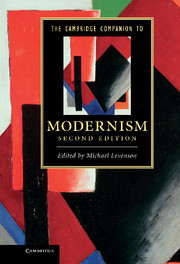Book contents
- Frontmatter
- Introduction
- 1 The metaphysics of Modernism
- 2 The cultural economy of Modernism
- 3 The Modernist novel
- 4 Modern poetry
- 5 Modernism in drama
- 6 Modernism and the politics of culture
- 7 Modernism and religion
- 8 Modernism and mass culture
- 9 Modernism and gender
- 10 Musical motives in Modernism
- 11 Modernism and the visual arts
- 12 Modernism and film
- 13 Modernism and colonialism
- Further reading
- Index
5 - Modernism in drama
Published online by Cambridge University Press: 28 September 2011
- Frontmatter
- Introduction
- 1 The metaphysics of Modernism
- 2 The cultural economy of Modernism
- 3 The Modernist novel
- 4 Modern poetry
- 5 Modernism in drama
- 6 Modernism and the politics of culture
- 7 Modernism and religion
- 8 Modernism and mass culture
- 9 Modernism and gender
- 10 Musical motives in Modernism
- 11 Modernism and the visual arts
- 12 Modernism and film
- 13 Modernism and colonialism
- Further reading
- Index
Summary
At first sight it might seem contradictory to include drama in a discussion of Modernism. As a movement "Modernism" has been defined in artistic terms through the sculptures of Jacob Epstein or Henri Gaudier-Brzeska and the paintings of Wassily Kandinsky or Wyndham Lewis, while in literary terms its usage has been restricted to the work of poets and novelists: pre-eminently T. S. Eliot, Ezra Pound, James Joyce, D. H. Lawrence, Virginia Woolf, and Gertrude Stein. Indeed, in the various critical studies of the movement, drama is seldom mentioned, and then generally dismissed as following a different - even antimodernist - agenda. This may be partly due to the specifically English and American focus of studies that site the defining moment of literary Modernism in the Pound-Eliot nexus. By contrast, drama in the twentieth century has been highly international, with English-speaking playwrights and directors responding to innovations from Europe, and having their experiments picked up in turn. It is also true that theatrical developments over the century do not fit the same chronological frame as for poetry or the novel, where the two decades from 1910 to 1930 are generally held to mark the boundaries of the movement.
- Type
- Chapter
- Information
- The Cambridge Companion to Modernism , pp. 128 - 154Publisher: Cambridge University PressPrint publication year: 2011
- 2
- Cited by

